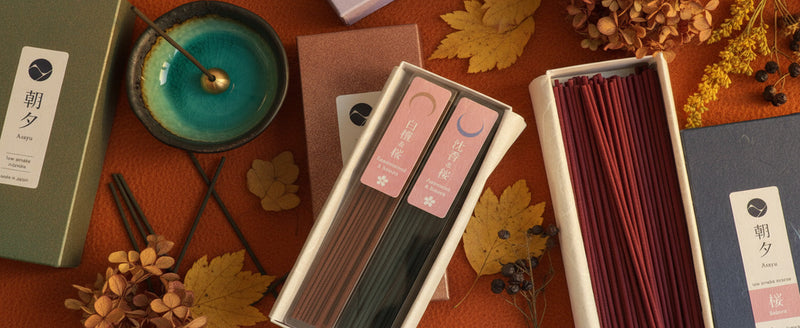
Sandalwood Incense & Japanese Culture: A Starter Guide

Have you ever been captivated by a scent that lingers in the air and fills your senses with a sense of calm? If so, then you can relate to the charms of sandalwood incense, as many people in Japan has done during centuries.
Let's explore together sandalwood incense and its profound significance for Japanese culture. Get ready for an exciting journey!
Where does sandalwood come from?
The magnificent sandalwood tree is the starting point of the sandalwood incense aroma. It's native to India and other parts of Southeast Asia, and it's revered for its fragrant heartwood. And many decades may pass for the heartwood resin to mature and develop its signature scent.
The sandalwood resin was used for centuries for creating incense, perfumes, or even medicines. The oil derived from the tree is popular for its rich, woody fragrance and therapeutic properties.
But this popularity lead to a high demand for sandalwood. And, so, to overexploitation, illegal trade, and significant depletion of sandalwood forests in Kenya, India, Australia... There are many efforts to find sustainable and ethical ways to preserve this natural resource. So take this into account when selecting your sandalwood incense sticks!

From Ancient Times to Present Day
Let's travel back in time and discover the fascinating history of sandalwood! The sweet-smelling wood was already appreciated by many ancient civilizations. From India to Egypt, from China to Southeast Asian cultures, sandalwood always played a big role in their spiritual practices.
But why did they regard sandalwood as a sacred and valuable resource? The answer lies in the spiritual symbolism of its captivating aroma. All these cultures used sandalwood fragrance for many purposes: create a harmonious environment, invoke blessings, serve as a tool to bridge the physical and spiritual worlds... This still valid in the present, since burning sandalwood incense is a common practice in Hinduism's holy rituals.
Aside from its spiritual significance, sandalwood has therapeutic applications as well. It's known for its cosmetic properties and used as a natural remedy for various ailments.
Did you know that sandalwood's popularity led to extensive exploration in history? The aromatic wood was in high demand in the West during the Age of Discovery. It prompted voyages to source and transport it from distant lands in Asia and Africa. This trade not only connected civilizations. It also contributed to the spread of sandalwood's influence across the globe.
Fast forward to modern times, and the allure of sandalwood remains strong. It's still a cherished ingredient in perfumery, cosmetics, and, of course, incense production. In fact, sandalwood incense has become one of the best ways to find inner peace, meditate and be more mindful.
Sandalwood and Japanese Incense
When it comes to sandalwood in Japan, it's not another pleasant scent. Sandalwood, also known as Byakudan (白檀) in Japanese, has a deep cultural and historical significance. It has been a staple in Japanese culture for centuries in many ways.
In which ways, you ask? Well, for starters, it goes beyond making a room smell good. In Japanese culture, sandalwood has been a staple incense ingredient for ages. And burning incense is an art form with the name of Kōdō, which means "Way of Incense." Those who take part in it heat the incense to experience the scents and deepen their connection with their surroundings. A real and authentic self-awareness practice!
But it's not only about the smell. Sandalwood incense has major spiritual significance in Japan as well. In Buddhism and Shinto they burn sandalwood incense sticks to create the right atmosphere for sacred rituals. They believe the scent purifies the surroundings and attracts positive spiritual energies. And, especially in Shinto, sandalwood is used to communicate with the gods.
Sandalwood is also a very popular material for traditional Japanese art. For example, you can find in many religious spaces sandalwood sculptures of gods or landscapes. This is in part to the sacred value of the sandalwood tree and represents a form of honoring these deities.
The aromatic scent is also present during Japanese tea ceremonies, known as Chadō or Sado. The sandalwood incense is burned at the beginning of the ceremony to set the space. This way, the participants gain a sense of purification and relaxation for the rest of the ritual.
And let's not forget the simple pleasure of burning sandalwood sticks in the comfort of your home! It is still quite a regular practice in Japanese households. No matter if it's for relaxation, spiritual purposes, or for the sake of enjoying a calming home aroma. It contributes to creating a serene and Zen inspired environment that many people look for.

What You Should Take Away From This…
Sandalwood is more than a pretty scent. It's a key player in history, spirituality, and medicine. Its presence spans across ancient rituals to modern-day life, making it a timeless favorite. It's like taking a whiff of the past and embracing our ancestors' wisdom to find peace and tranquility in the present.
In Japan, sandalwood is a big deal, and it's not hard to see why. From religious rituals to artistic expression, its fragrance has become a staple in many traditional practices. Like a portal to the past, it gives us a glimpse into the pursuit of harmony so persistent in Japanese culture.
As we light a stick of sandalwood incense, we embark on an aromatic journey that connects us to something bigger than ourselves. It's an opportunity for inner reflection, appreciation, and relaxation. The fragrance of sandalwood encourages a sense of serenity, of creating a calm and peaceful space.
So, whether you're taking part in a traditional ceremony or simply enjoying the fragrance at home, sandalwood is there to guide you on a journey of mindfulness. This timeless treasure continues to become a tool for connecting with the past and be a source of tranquility in the present.
Where to Start with Sandalwood incense?
Asayu Japan’s low smoke sandalwood incense can be a great starting point in this exciting journey. They are crafted by local Japanese artisans from Awaji Island. So, you can see they are proof of the deep relation of sandalwood and Japanese culture!
Plus, the low smoke formula provides the many benefits of sandalwood without the irritation of the incense smoke.
Give it a try and elevate your meditation and self-care rituals. Create an environment where mindfulness and serenity are at the center of everything. Enjoy! And let us know your thoughts in the comments below!
Asayu Japan Team


